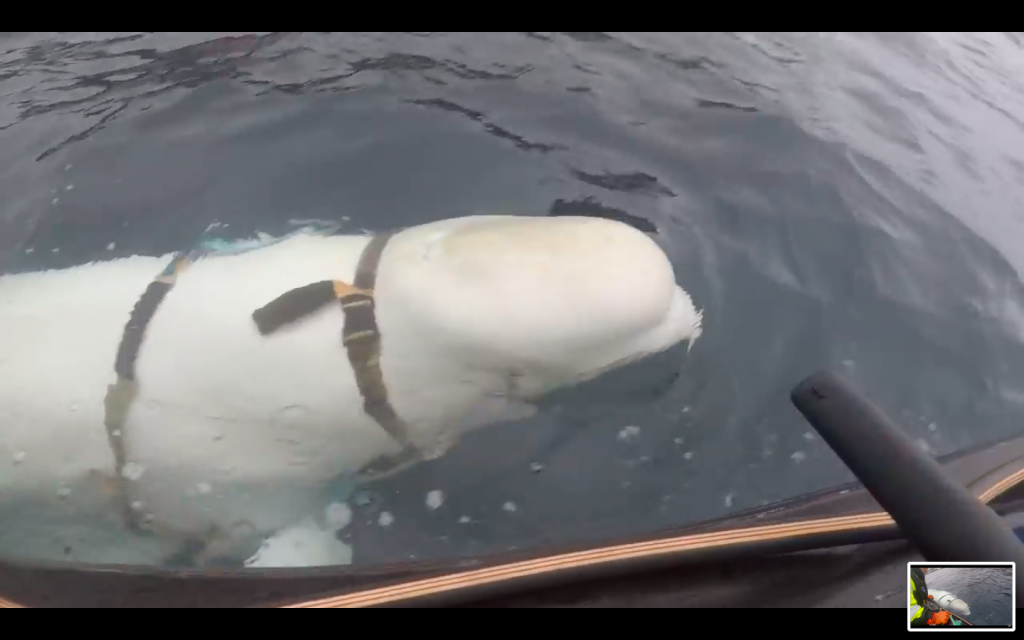
Two weeks ago, on 26 April, a Beluga Whale surprised fishermen in the Arctic waters off the northern coast of Norway. Worried about it damaging nets and tackle, they kept an eye on the toothed whale as it pulled at straps and fittings around their boats. Then they spotted the tightly fitted harness around its neck. Seeing that the animal was tame and accustomed to being near humans, a fisherman entered the freezing water and managed to remove the harness. It was stamped: “Equipment St. Petersburg.”
What was a Russian white whale doing in Norwegian waters? Ivan Whale offered only a few clicks and whistles when interrogated, and Norwegian authorities and fishermen had no choice but to send him on his way – after a hearty fish lunch. So we’ll have to guess who might have sent him into Norwegian territorial waters and why they did it.
The whale certainly did not swim to Norway’s High North from St. Petersburg, some two thousand miles distant, so the best guess is that he came from a Russian naval organization at Olavsvern, the secret naval base that the Oslo government sold to a Norwegian businessman for the bargain basement price of $5 million. Carved under a mountain, construction of the huge submarine pen cost more than ten times that amount. The businessman then rented the base to Russia. In figuring out ownership of the whale, it is also useful to note that the Kremlin has reopened three Soviet-era military bases along its Arctic border, reinforcing the probability that Ivan was a Russian military whale.
The next question is why would Russian sailors at Olavsvernput a harness on a Beluga whale, the large first cousin to a dolphin? The obvious answer is that Ivan Whale was trained to do tasks for its human friends, just as dolphins do at Orlando’s Seaworldto delight the tourists. But a Beluga whale, though a member of the cetacean family, cannot swim nearly as fast as a dolphin or leap out of the water to get hand and voice signals from a trainer. So why a whale instead of a dolphin? Perhaps the reason is that a Beluga whale can dive to 3,000 feet, three times deeper than a dolphin. That would make it uniquely useful for several military tasks, including guarding the deep underwater approaches to a submarine pen like Olavsvern.
The list of skills that dolphins, whales and sea lions can acquire is amazing, and is based on their intelligence, their affinity for humans, and their extraordinary attributes. They include:
- Mine hunting.The biological sonar system located in the foreheads of dolphins and Beluga whales is better than any mechanical sonar ever built. Emitting clicks and analyzing the return echoes, it enables them to “see” things that humans cannot, like mines buried in silt. They can also detect swimmers by using their sonar to bounce echoes off their skeletons.
- Equipment recovery. Dolphins have helped recovery of expensive training torpedoes for reuse.
- Surveillance.It is entirely conceivable that a small video camera could be attached to a whale harness to record underwater defenses and even submarines.
- Tracking.A tracking device, fastened to a powerful magnet, could be attached by a Beluga whale to the hull of a target ship or submarine.
Predictably, animal rights activists deplore the militarization of these astounding animals, and worry about the possibility of training them to kill humans or destroy ships and submarines. Just as predictably, navies and research facilities of nations who train dolphins and whales dismiss the notion of murderous dolphins or kamikaze whales.
Nevertheless, dolphins have already been trained to quickly “mark” underwater frogmen and return to their handlers in boats above – who could then drop concussion grenades on the swimmers below. Being playful or annoyed, dolphins have also rammed their trainers at high speed, causing the trainer to get medical treatment. It follows, therefore, that training a whale or dolphin to ram a ship or submarine with an explosive on a suicide mission would not be impossible. Would the U.S. Navy set out to find a Dr. Strangelove willing to train killer dolphins or whales? That would be extremely unlikely if for no other reason than it would be impossible to keep it a secret.
But would President Putin, today’s creator of doomsday weapons, hesitate to authorize deadly dolphins? Not likely.
Chet Nagle was a research project officer at the U.S. Naval Oceanographic Office.


1 comment
Mr. Nagle wrote, “Would the U.S. Navy set out to find a Dr. Strangelove willing to train killer dolphins or whales?”
Stanley Kubrick would be amused. It was also demonstrated in the George C. Scott movie “The Day of the Dolphin” that they don’t always place the “package” where you want it. You’ve got to remember, you’re dealing with a creature with a sense of humor – and a taste for revenge.
In the wild, these creatures name themselves, use tools, communicate and cooperate. The work of Dr. Lori Marino and Dr. Diana Reiss has demonstrated conclusively that they recognize themselves in a mirror. Since ancient times they have been known to rescue us from danger and drowning on the high seas.
Isn’t it time we gave them what they need to survive: clean, quiet seas, plentiful fish, freedom from harassment? Maybe when we’ve cleaned up our act, they’ll be willing to communicate.